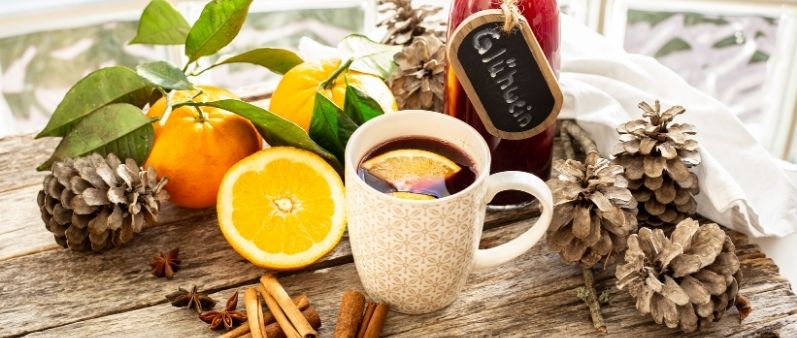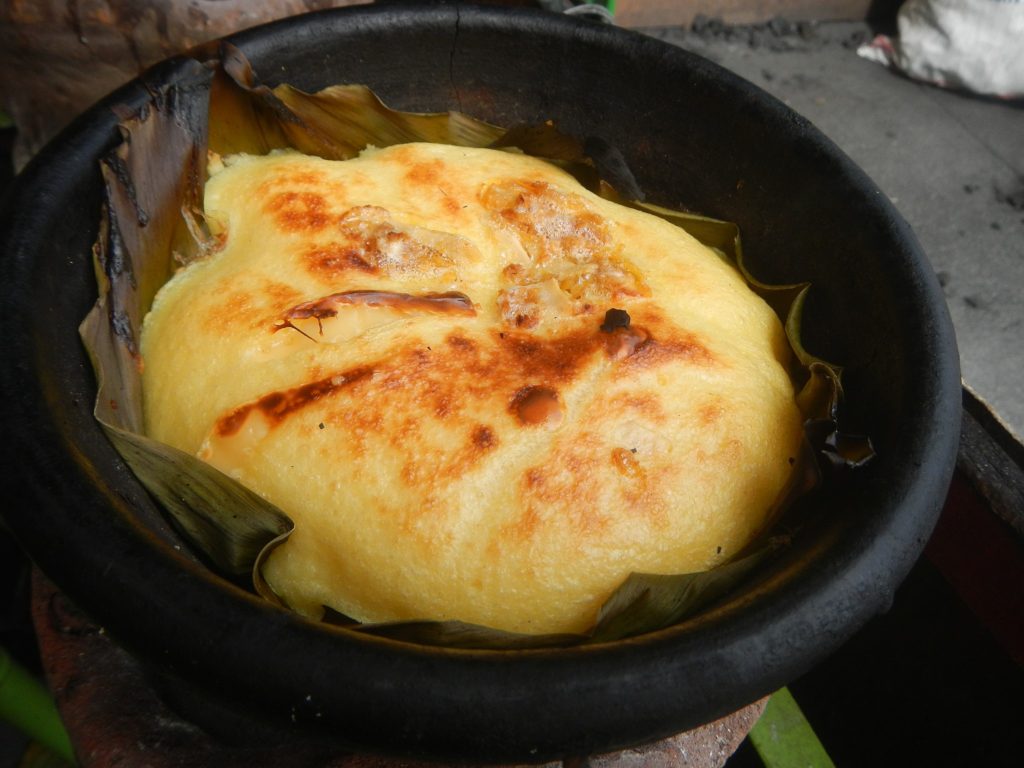
Festive Holiday Recipes From Around the World to Spice Up Your Celebrations
It’s that time of year again.
And while many familiar signs of the holiday season have begun to appear—Christmas music on the radio, mint chocolate mochas on the menu of your favorite cafe, some anxiety about what you’ll get your partner—things definitely feel strange this year.
In the spirit of leaning into—and even celebrating—the unusual, we’ve collected 7 traditional holiday recipes from around the world. After all, the holidays are for cooking (and cooking also happens to be a great way to learn a new language!)
We welcome you to use these to spice up your traditional holiday meal and find some pleasure in celebrating a bit differently.
Traditional Holiday Recipes to Celebrate Your Language Learning this Season
1. Glühwein (Germany)
Glühwein (“glowing wine”) is a traditional German holiday drink, commonly found in the Christmas markets that pop up around Germany this time of year. It’s the German version of mulled wine—a warm, citrus-ey red wine drink that will liven up your holiday party—even if that’s just the 3 people in your COVID bubble.
Looking for a kid-friendly version? Try Kinderpunsch.
Ingredients
- 1 orange, halved and sliced
- 1 bottle of red wine
- 200g caster sugar
- 5 cloves
- 1 cinnamon stick
- 2 pieces of star anise
- 3 slices fresh ginger (peeled)
- 150ml brandy, rum, amaretto or schnapps
Method
- Warm the sliced oranges, wine, sugar, cloves, cinnamon, star anise, and ginger together in a large pan for 10 to 15 minutes. It should get hot, but be careful not to let it boil.
- When it’s finished warming, add the brandy, rum, amaretto, or schnapps.
- Pour into glasses (or mugs, if you want to be traditional) and serve warm.
2. Latkes (Israel)
Latkes are fried potato pancakes that are traditionally served during Hanukkah. They make a delicious—and filling—addition to any holiday feast. They’re also great for helping use up the leftovers: just swap out grated potatoes for your left-over mashed potatoes, and you’re good to go.
Ingredients
- 1 1/2 pounds baking potatoes (3 to 4 potatoes)
- 1/2 medium yellow onion, peeled and quartered
- 1 large egg
- 2 tablespoons matzo meal or unseasoned dry breadcrumbs
- 1 teaspoon kosher salt
- 1/8 teaspoon freshly ground black pepper
- 1 cup canola oil, or chicken schmaltz, or a combination of both
- Applesauce and sour cream for serving
Method
- Heat the oven to 200°F. Line a baking sheet with paper towels. You’ll put the latkes here to keep them warm after you’ve fried them.
- Scrub the potatoes and cut them in half crosswise.
- Grate the potatoes and the onion. You can use a grater or a food processor.
- Squeeze the liquid from the potatoes using a cheesecloth or press them with a tea towel.
- Mix the potatoes, onion, eggs, matzo meal or breadcrumbs, salt, and pepper in the bowl with your fingers. Set aside for ten minutes.
- Heat the oil in a large frying pan over medium-high heat. Form the latkes with your fingers and fry on both sides until golden brown. Place in oven.
- When ready, serve with applesauce or sour cream
3. Spiced Hot Chocolate (Peru)
Nothing is better than curling up with a mug of hot chocolate and watching a movie during the holidays. This year, keep it interesting with a Peruvian spiced version of hot chocolate. Learn Spanish simultaneously by pairing your warm mug of chocolatey goodness with one of the top Spanish TV shows on Netflix.
Ingredients
- 1/8 cup Cinnamon Sugar
- 1/4 cup Cocoa
- 1/2 tsp. Ground Cloves
- 4 cups milk, almond, or soy milk
- 1 – 14 oz. can sweetened condensed milk
- 1 – 12 oz. can evaporated milk
- 1/2 cup chopped Latin drinking chocolate bar (or other dart chocolate)
- 1 Tbsp. cornstarch
- Optional toppings: whipped cream, marshmallows, chocolate syrup, chocolate shavings
Method
- Add the milk and cinnamon sugar together to a saucepan. Heat it over medium heat until it begins to boil. Stir frequently.
- Mix in sweetened condensed milk and evaporated milk. Then simmer over medium heat for 2 mins.
- Add the chocolate, cocoa, and ground cloves to the pot of milk and heat on low for 5 minutes, stirring to melt the chocolate.
- Separately, dissolve the cornstarch in ¼ cup water. When it’s dissolved, add the mixture to milk and chocolate, stirring continuously. Heat on low for 2 more mins.
- Remove from heat, add optional toppings, and serve.
4. Bûche de Noël (France)
No French Christmas feast is complete without the Bûche de Noël (“Christmas log”). This rich and gourmet cake is a treat for the taste buds and your guests. It’s made of a tender sponge cake, wrapped and filled with chocolate buttercream. It’s light and delicious and will leave you genuinely exclaiming, oh la la.
Ingredients
For the sponge cake:
- 4 eggs
- 80 g brown sugar
- 25 g flour
- 45 g of cornstarch
- 1 packet of dry yeast
For the buttercream:
- 250 g unsalted butter
- 140 g icing sugar
- 1 whole egg
- 2 egg yolks
- 4 tbsp. chocolate powder
Method
The sponge cake:
- Preheat the oven to 350 ° F.
- Mix the eggs and sugar in an electric mixer until they double in volume.
- Then, add the flour, cornstarch, and baking powder. Mix together until combined.
- Pour the batter onto a baking sheet lined with parchment paper and cook for 8 min. Turn it over on a damp cloth and roll it up.
Buttercream:
- Add the whole egg, egg yolks, and icing sugar in a bowl (use an electric mixer if you have one). Mix on low speed for 10 minutes. Add the chocolate powder and continue to mix.
- Cut the butter into pieces and incorporate into the mixture with one piece of butter every 20 seconds.
- Stop when the last piece of butter is incorporated.
Putting it together:
- Carefully unroll the sponge cake. Spread some buttercream on the sponge cake and roll it back into a log. Cover the log with the remaining buttercream. Using a fork, make streaks and decorate as you wish.
5. Bibingka (Philippines)

Bibingka is a classic baked rice cake common in the Philippines and Indonesia. It’s often eaten for breakfast, especially during the Christmas season. They are also sold outside churches during novenas, a nine-day worship service common throughout the Philippines, and worshippers eat them for breakfast.
Passionate about the Philippines? Bibingka also makes a great study snack while you learn Tagalog.
Ingredients
- 1 cup rice flour
- 1/4 cup all-purpose flour
- 1/2 cup sugar
- 3/4 cup milk
- 1/4 cup water
- 2 teaspoons baking powder
- 1/4 teaspoon salt
- 4 tablespoons vegetable oil
- 1 egg
Toppings
- grated cheese
- grated coconut
- butter, melted at room temperature for brushing
Method
- Line pans or molds with baking paper (or banana leaves if you have them!) and brush with butter. You can use regular loaf pans or muffin tins. Set aside.
- Combine all the ingredients together and mix well until the batter is smooth. It should be quite runny.
- Divide the mixture into the pans/molds. Arrange them on the baking sheet and bake at 200°C/390°F in the middle rack for 10 minutes. At this point, you can turn on the broil or grill function and bake for another 5 minutes or until nicely charred.
- Remove from oven and brush each Bibingka with butter. Then top them with grated cheese and grated coconut. Serve while warm!
6. Hangikjöt (Iceland)
Hangikjöt is just a kind of smoked lamb that’s a traditional Christmas dish in Iceland. It’s historically smoked using dried sheep’s dung, but you probably don’t need the full traditional experience with this one—a traditional smoker that uses just plain ole’ wood will work fine.
Want to be able to pronounce Hangikjöt properly? Try Pimsleur’s program to learn Icelandic.
Ingredients
- Half leg of lamb (ask your butcher to tunnel bone one for you)
- Brine solution (salt, sugar, and nitrates)
- Wood for smoking
- A smoker
Method
- Soak the leg overnight in a standard brine solution (salt, sugar, nitrates)
- Drain the lamb and leave it in the fridge for a day or two so that it forms a pellicle.
- Smoke for about 48 hours.
- When it’s done smoking, leave it in the fridge for at least four days so that the smokey flavor matures and permeates.
- Before serving, poach the lamb for 30 to 60 minutes, depending on size. Slice and serve pink.
- Hangikjöt is traditionally served with canned peas, plain boiled potatoes, and béchamel sauce. It can also be served cold on bread.
7. Risgrynsgröt (Swedish)
Another classic Nordic dish, Risgrynsgröt, is Sweden’s answer to rice pudding. It’s typically eaten for breakfast or as a starter to the main Christmas meal. It’s creamy and delicious, and one pot will feed the whole family. For an extra Swedish tradition, add an almond to the pot… the person who gets it in their bowl gets a small gift (often it’s a piece of chocolate!).
Ingredients
- 2 cups water
- ½ tsp salt
- 1 Tbsp butter
- 1 cup rice (ideally short-grain rice, like pearl arborio)
- 4 1/3 cups milk
- 1 cinnamon stick
- 1/4 cup sugar
- 1/4 cup raisins
Method
- Boil the water in a saucepan with the salt, butter, and the stick of cinnamon.
- Add the rice and cover. Simmer for 10 minutes on low heat.
- Add the milk and increase the heat so that it comes to a boil. Then turn to low, cover, and cook for about 30 minutes. Add the raisins after about 20 minutes.
- Add sugar and then serve warm.
Language Learning Anytime and Anywhere!
The full Pimsleur course adds up to a $575 value. And that’s what many solo language learners, businesses, and government agencies have been happy to pay in the past… But that’s NOT what we want you to pay with this new offer. Instead, you can use Pimsleur and all its contents — from beginner to fluency — starting at just $14.95 monthly. You get immediate access to all lessons. You can also cancel your monthly subscription anytime—no hassles or questions asked.
That’s not it, though…
For joining Pimsleur today, we also want to send you a free copy of Dr. Pimsleur’s e-book “How to Learn a Foreign Language.” This e-book sells on Amazon for $10.99… but it’s yours today FREE! Inside, Dr. Pimsleur shares in simple terms the results of his studies and how to learn languages the fastest way possible. It’s yours to keep even if you cancel during the 7-day free trial and don’t pay us anything! Consider it our gift to you for giving Pimsleur a try.

1 Comment for "Festive Holiday Recipes From Around the World to Spice Up Your Celebrations"
The strangest thing on the list is the Spiced Hot Chocolate. I can’t imagine what it would taste like. Still, it’s great that every country has a different holiday meal. I know that in Japan the holiday food is soba – buckwheat noodles (a New Year’s Eve food). And at Christmas, they eat fast food from KFC. Aren’t these people weird?